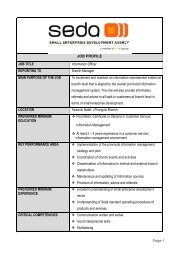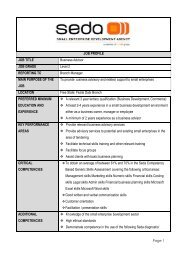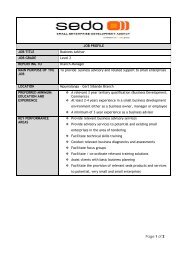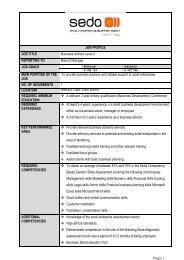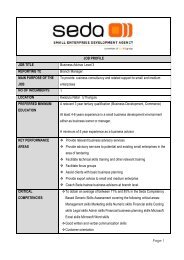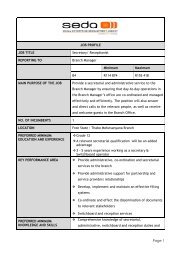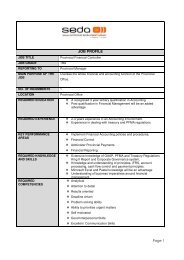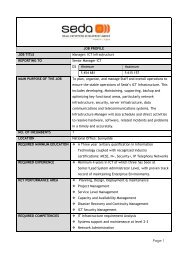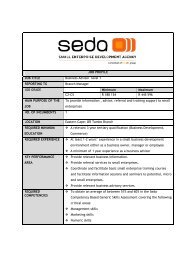Assessment of Cooperatives in the Poultry Industry - 2013.pdf - Seda
Assessment of Cooperatives in the Poultry Industry - 2013.pdf - Seda
Assessment of Cooperatives in the Poultry Industry - 2013.pdf - Seda
Create successful ePaper yourself
Turn your PDF publications into a flip-book with our unique Google optimized e-Paper software.
Research Report: Address<strong>in</strong>g <strong>the</strong> Needs, Opportunities and Challenges <strong>of</strong> <strong>Cooperatives</strong><br />
and Collectively Owned Enterprises <strong>in</strong> <strong>the</strong> <strong>Poultry</strong> and Related Industries<br />
The discrepancy between <strong>the</strong> CIPC registration figures and <strong>the</strong> age sample from <strong>the</strong> survey illustrates<br />
<strong>the</strong> short life span <strong>of</strong> many <strong>of</strong> <strong>the</strong> cooperatives. In any given year <strong>the</strong>re may be a large number <strong>of</strong><br />
cooperatives register<strong>in</strong>g. However, over time <strong>the</strong> number <strong>of</strong> susta<strong>in</strong>able cooperatives that cont<strong>in</strong>ue<br />
to be operational dim<strong>in</strong>ishes.<br />
Figure 4-2: Year <strong>of</strong> Registration for all active <strong>Poultry</strong> <strong>Cooperatives</strong> registered with <strong>the</strong> CIPC<br />
3 000<br />
2 500<br />
2 000<br />
1 500<br />
1 000<br />
500<br />
-<br />
2002 2004 2006 2008 2010 2012 2014<br />
Source: Urban-Econ Survey, 2013<br />
The form <strong>of</strong> bus<strong>in</strong>ess run by cooperatives provides an understand<strong>in</strong>g <strong>of</strong> <strong>the</strong> bus<strong>in</strong>ess types<br />
cooperatives view as feasible. Bus<strong>in</strong>ess type also provides <strong>in</strong>formation around <strong>the</strong> specialised forms<br />
<strong>of</strong> technical support which are most needed.<br />
Many <strong>of</strong> <strong>the</strong> cooperatives surveyed comprised different bus<strong>in</strong>ess types or performed a number <strong>of</strong><br />
different functions. For example, some are breed<strong>in</strong>g, grow<strong>in</strong>g and sell<strong>in</strong>g broilers, while o<strong>the</strong>rs deal<br />
only with egg lay<strong>in</strong>g. The graph below (Figure 4-3) illustrates <strong>the</strong> number <strong>of</strong> different bus<strong>in</strong>ess<br />
functions reported by each cooperative surveyed.<br />
The highest number <strong>of</strong> bus<strong>in</strong>ess functions reported by a s<strong>in</strong>gle cooperative was six, with only one<br />
cooperative operat<strong>in</strong>g so diversely. The majority <strong>of</strong> cooperatives (71.4%) are undertak<strong>in</strong>g two or<br />
three different bus<strong>in</strong>ess functions.<br />
38 | P a g e U r b a n - E c o n : D e v e l o p m e n t E c o n o m i s t s



